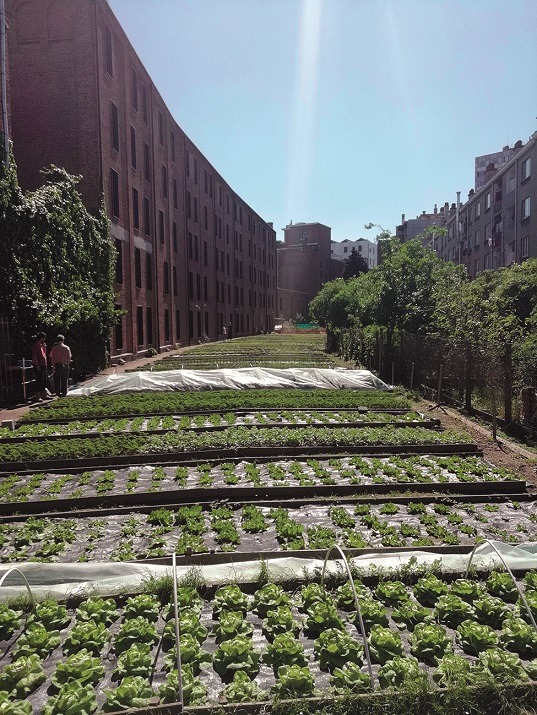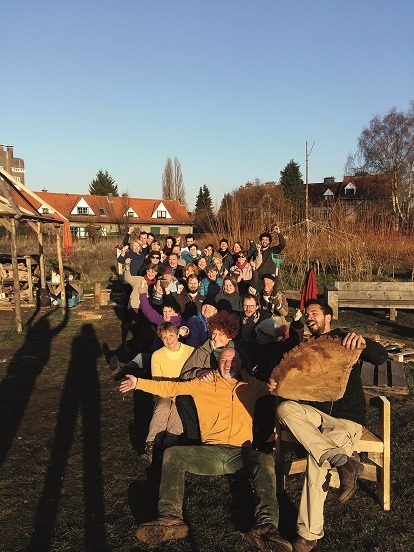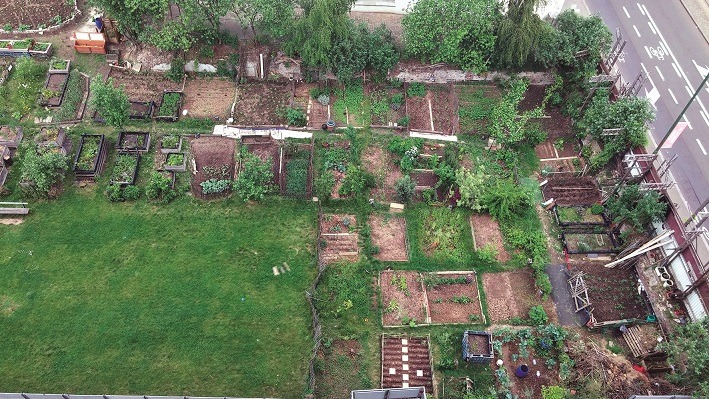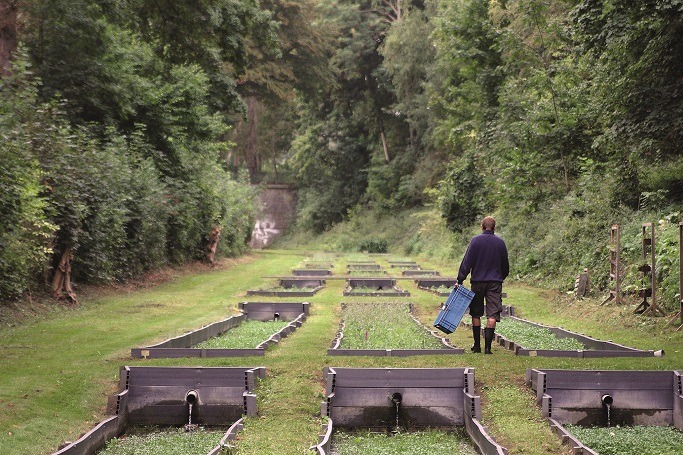Brussels is much more than a capital with half its territory made up of public parks and private gardens: it is actually a playground for more and more citizens willing to grow their own food, individually or collectively. And more and more businesses are taking advantage of a steady ‘eat local’ trend. How big is urban agriculture in Brussels, and what kind of environmental, social and economic benefits does it bring? “Hello everyone! What about leaves? In view of mulching the containers, a few dozen bags of leaves will be necessary. Leaves in excess will be used to complete our stock of brown matter at the compost. Thierry will soon harvest a few bags from his own garden. Ellen suggested getting leaves from Avenue Lambeau: a genuine yellow carpet is covering the pavement. I suggest putting the bags next to the compost at Parc Timmermans….”
I get this kind of email every other day since I’m part of a neighbourhood garden in Woluwe-Saint-Lambert. When I registered a year ago, I was looking for some physical activity rather than integrating into a new community or making new friends. But I did, like thousands of other Brussels residents, who devote a few afternoons a month to plough, cut, prune, seed, water, mulch, build and harvest in one of the city’s 400 urban gardens.
A new guide to Brussels' urban gardens, recently published by Christophe and Jacques Mercier, describes some of them: Paysages citoyens à Bruxelles – 50 lieux où la nature et l’humanité ont repris leurs droits (Citizens’ landscapes in Brussels – 50 spots where nature and humanity have reclaimed their rights). The book is a non-exhaustive breath of fresh air and shows the diversity of urban farming and citizens’ initiatives in Brussels.
The authors recall the concept's origins in Manhattan’s East Side in New York. Some inhabitants there occupied urban wastelands abandoned by estate speculation. That’s where the first community gardens were born.
And they had their heroine: Liz Christy, an artist, who was throwing seed bombs over fences to transform the areas into gardens. Citizens organised and formed green guerrillas, until the municipality launched a programme called Green Thumb to boost the development of these green spots. Today, there are more than a thousand in the Big Apple, and they have spread around the world: Montreal, Tokyo, Berlin, Lille, Paris and… Brussels.
Making the city more edible
According to Marc Dufrêne, specialist of ecosystem services and innovation at the Gembloux Faculty (University of Liège), which specialises in agriculture, urban farming ticks the three pillars of sustainable development: it contributes to production, it boosts social integration and it improves the environment and health.

Bel Mundo © Atelier Groot Eiland, Lene Van Langenhove, Lies Engelen
“Colonisation by vegetation of wastelands, rooftops and vertical areas leads to a significant improvement of climate regulation and air quality in cities,” he explains. These zones absorb a lot of sun, produce oxygen, capture dust and help to recycle a big part of organic waste – half of the 400kg of domestic waste produced annually by each inhabitant, in the case of Brussels.
More vegetal cover also helps soak up steady rain and mitigate flooding peaks. “Thanks to this living epidermis, the city not only breathes but it sweats,” Dufrêne sums up.
But one of the most positive and interesting aspects of urban gardening is its socio-cultural dimension. “It is well known that the presence of green areas in an urban landscape contributes a lot to physical and mental health, rehabilitation after a disease and even life expectancy,” Dufrêne continues.
The physical activity linked to gardening improves general health. It helps one become aware of how nature works and conscious of the human impact on it: consumption patterns, eating habits, and waste management.

Ferme du chant des Cailles © La Ferme du chant des Cailles asbl
But it goes further than that, since harvesting and sharing the fruits of the effort also brings a sense of fulfilment: “The psychological benefits are significant,” Dufrêne says. Urban agriculture won’t solve all of a city's problems, but it can help. “The future of cities will depend upon our capacity to create and innovate to make it more bearable, more edible,” he concludes.
As far as economic benefits are concerned, Haïssam Jijakli, who heads the Centre of Research in Urban Agriculture at Gembloux (C-RAU), praises the quality of production from urban agriculture. “It is value creation, since you transform unexploited areas into quality products, within an endogenous economy where money stays local for longer,” he explains.
The jobs created primarily benefit a low-skilled workforce, who not only learn new skills, but also reintegrate into society. Public authorities encourage these kinds of initiatives more and more because it increases the value of their territory. The C-RAU recently drafted a 'Good Food' plan for the Brussels Region plus a strategy to integrate urban agriculture, proof that its economic potential is being taken seriously by the authorities.
Grow your own
Urban agriculture in Brussels is made of a buoyant network of institutions, associations, lobbies, citizens and start-ups. Let’s explore this lush ecosystem despite the lack of centralised data, given the multitude of players. What is clear is that things have been changing over the last five years, as shown by the number (+33%) and diversity of initiatives.
The Brussels Region's Ministry of Environment (Bruxelles Environnement) tries to coordinate the development of urban agriculture by providing guidance, tools, training, advisors, basic information and even money. Their website www.potagersurbains.be seeks to be the focal point for all urban gardens in the region.
The Ministry also provides some guidance for setting up gardens in schools, which has seen 84 new projects since 2015. The association Le Début des Haricots has published a guide on starting a collective garden. To grow your own, you first need a place. On its own website, the Ministry displays a unique interactive map, the carte de l’état du sol (a ‘state-of-the-ground’ map).
This provides a lot of information about each unconstructed spot in the region, which has been validated by the Ministry. It is very useful to know if a certain patch of soil is polluted. Le Début des Haricots advises looking for unoccupied public spaces, urban wastelands next to railroad tracks, unauthorised landfills or flat roofs – and their owners.
Then you need organic fertilizer. Bruxelles Environnement launched a network of master composters in 1998. Trained by the association Worms, some 180 volunteers stand ready to share their passion and knowledge of composting. Every year, around 15 collective compost heaps are created – there are 165 in Brussels today.
Next you need some advice on how to grow your own. The 100+ maîtres-maraîchers (master gardeners) of Brussels are here to help. They are also volunteers and they are coordinated and trained by the association Tournesol (sunflower). Finally, you may want some guidance on how to run your collective garden, which will bring you back to Le Début des Haricots. Since 2007, they have accompanied the creation of dozens of collective gardens in Brussels’ communes. They even set up a unique nursery garden in Saint-Gilles to boost gardening on balconies.
Some associations are active specifically in the sector of fruits, because there are already lots of fruit trees in Brussels. The Flemish-Dutch association Velt has mapped out the region’s 100+ orchards. They help some gardens in Brussels to grow fruits, such as at Parckfarm at Tour & Taxis (Molenbeek). You can register your tree to get guidance for pruning and help for harvesting within the framework Verger partagé (shared orchard).
Flore et Pomone, from Wallonia, take care of the collective gardens of Etterbeek, run by the commune, with the help of a dozen partner associations. FruitCollect harvests fruits from all over Brussels and Wallonia, to give them to social organisations: “We are the link between people who have too much and people who don’t have enough,” says Maxime Niego, FruitCollect’s Founder. They communicate a lot via social networks to make sure they are in orchard owners’ minds when harvesting time comes.

Marais du Wiels - Paysages citoyens © Myriam Rispens
As far as financial support is concerned, collective gardens in Brussels run the gamut from pure self-management to full support from local associations. Bruxelles Environnement offers up to €3,000 to five projects a year in the framework of its call for projects Inspirons le Quartier (Inspire the Neighbourhood).
The Roi Beaudouin Foundation also provides some financing. And finally, the communes themselves are a possible source of help since a collective garden is generally a project to help create or maintain social cohesion in a neighbourhood and usually leads to many satellite activities. All in all, some 172 urban gardening projects have been supported in Brussels since the end of 2015.
Green biz
If 79 hectares of land are occupied by urban gardens, the Brussels Region has a total potential of 240 hectares of agricultural land to feed its population. There were 30 professional agriculture projects in the region in 2018, almost twice the number of 2015. Bruxelles Environnement offers training and a chance to experiment to wannabe farmers through the EU-sponsored project BoereBruxselPaysans.
Thanks to a few pioneers, the Region already hosts genuine farms such as La Ferme Nos Pilifs in Neder-over-Hembeek (private), La Ferme Urbaine in Neder-over-Hembeek (run by Le Début des Haricots), La Ferme du Chant des Cailles in Watermael-Boitsfort (run by a cooperative of inhabitants and professional farmers), and Betteraves Enz and InnRgreen in Anderlecht (run by Vert d’Iris).
Usually these bigger projects are at the heart of many other initiatives regarding fresh food, such as education, training, social, shops, cultural, events, breeding, fruit production, beehives, etc. The overall supply of fresh food is still very small compared to demand in the region (1.1 million inhabitants). Nevertheless, some supply paths are professionally organised, either through GASAPs (collective purchasing groups) or directly to shops (e.g. TAN, Färm) or even to restaurants such as Le Max (Schaerbeek) or ChezWawa (Ixelles).
Vert d’Iris also has a unique collaboration with Brasserie Cantillon: they have planted a whole orchard of cherry trees which will supply the brewery’s raw material for its kriek beer. And did you know that there’s a sheep farm behind the Erasmus Hospital?
Besides the above-mentioned farms, private projects aimed at doing business around urban agriculture are booming in Brussels. Flat rooftops have a bright future, provided the constraints of accessibility, resistance and safety are overcome. “Some companies that own buildings want to give something more to their employees and are setting up vegetable gardens where they can socialise,” explains Stéphane De Swaef from Nimaculteurs. He advises and trains private people and companies on how to set up permaculture gardens.
“I train city dwellers who have no knowledge of the agricultural universe,” he says. The association Groupe One, financed by the regions of Brussels and Wallonia, offers guidance to sustainable entrepreneurs with a module on urban farming. Fifty wannabe entrepreneurs are trained annually at their small aquapony farm in Saint-Gilles.
Skyfarms, another outfit that offers guidance to future urban farmers, be they private or corporate, has already installed its bags and containers on several roofs or in some courtyards in Brussels. And in 2016, Haïssam Jijakli and Candice Leloup created a Gembloux spin-off called Green SURF, which offers guidance on any urban farming project. Amongst others, they worked on a project at the brand new Delta hospital in Auderghem.
Peas & Love, founded by the consultancy Urban Farm Company, has inaugurated an interesting business model on the rooftop of fashion outlet Caméléon in Woluwe-Saint-Lambert. You can rent one of the 71 three-square metre slots for less than €9 a week and harvest fresh vegetables and fruits all year long – while a community farmer takes care of the hard work.
Finally, even futurist farms without soil are bursting forth in Brussels. BIGH’s 2,000m2 farm, on the roof of Anderlecht’s slaughterhouse, will produce vegetables and fish through aquapony. Meanwhile, Le Champignon de Bruxelles grows Japanese mushrooms on spent brewery grains in the 750m2 Caves de Cureghem underneath the slaughterhouse. And Urbi Leaf grows sprouts with LEDs in a cellar under Ateliers des Tanneurs in the city centre.
Act of rebellion
“It’s a strong but fragile movement,” says Christophe Mercier, co-author of the recent new guide to Brussels’ urban gardens. “Today, the situation is a happy one. But to keep the momentum up, we need to be vigilant, because Brussels’ population is growing and it’s profitable to build housing. A lot of urban wasteland will be built upon in the years to come and it will erase some spaces, which have become essential for social and environmental cohesion.”
“Public authorities should review their priorities: shouldn’t we first densify already-built areas before throwing ourselves at greenfield building plots? Because most of them have become green spots, necessary to the ecosystem and to the social functioning of the city,” Mercier warns.
Soil sealing was the #1 environmental theme at the local elections in October because extending the residential environment provokes floods when it’s raining and heat islands during summer. “Kids grow up surrounded by concrete. The playgrounds are overpopulated and often too artificial,” according to the Blog des Jardiniers (Gardeners’ Blog – tuiniersforumdesjardiniers.be) in its ‘Appeal to stop the destruction of the soils’. “It is necessary to recreate new natural areas rather than allow speculative construction.”
Coming from the countryside, I didn’t know that city gardening was an act of rebellion. For me, it was natural to maintain a physical contact with earth and nature. But here in Brussels, it’s a challenge and even a political statement.
For Mercier, “the metropole has always been agitated by urban fights” such as in the Marolles in the ‘70s and more recently in the run-up to the rehabilitation of Flagey square. “The current re-conquest of green landscapes fits into this historical narrative,” he says.
By Hughes Belin

